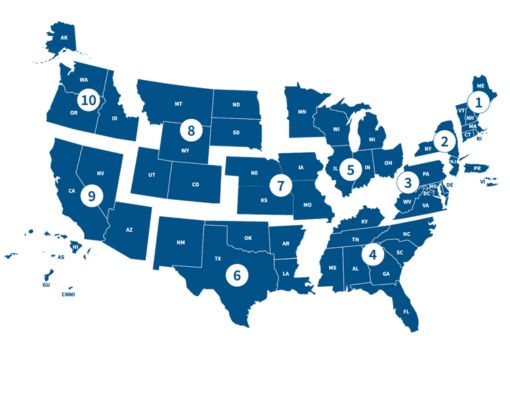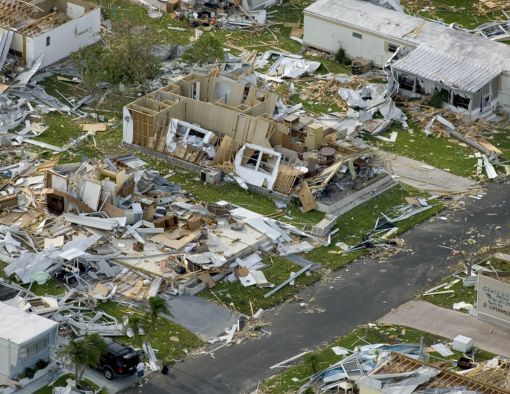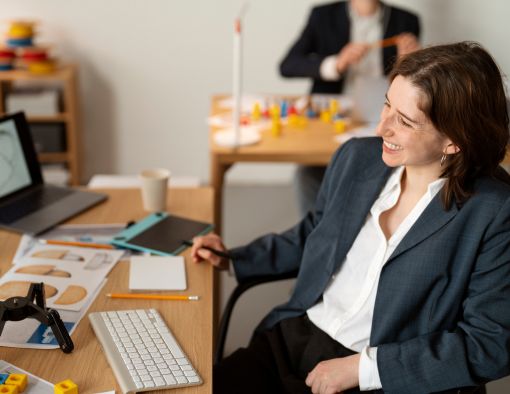Dealing with Disasters From an Individual Tax Perspective
When natural disasters strike, financial challenges often follow, but individuals can leverage key IRS provisions to mitigate tax burdens. The IRS offers various forms of disaster-related tax relief, from administrative extensions to casualty loss claims. Understanding these relief options helps taxpayers make informed decisions during a time of crisis.

The Blueprint Moves Blog

Administrative Relief and Tax Relief
Administrative relief is a cornerstone of the IRS’s disaster response system, designed to give affected taxpayers more time to meet crucial tax deadlines. However, this relief is not automatically granted in all cases. It is tightly regulated and depends on several conditions that must be met for a taxpayer to qualify.
Conditions for Administrative Relief
For administrative relief to be applicable, the disaster must be federally declared. This is a crucial condition—without this official declaration, the IRS cannot legally extend deadlines or provide the various types of relief that taxpayers rely on during recovery.
Once a federal disaster declaration is made, taxpayers located in the disaster area automatically qualify for administrative relief. This includes extensions on filing returns, paying taxes, and other time-sensitive actions, such as contributing to retirement accounts or making estimated tax payments. For instance, if a disaster declaration is made in March, taxpayers in that area might receive an automatic 180-day extension for the April 15th tax filing deadline.
The IRS grants these extensions based on specific guidelines, typically offering between 120 and 180 days of additional time. In extreme cases, such as disasters with widespread impact, the relief period may extend up to a full year. However, this timeframe is at the discretion of the Secretary of the Treasury.
Key Relief Measures Granted
The IRS offers several critical forms of administrative relief, including:
- Extensions to File and Pay: Taxpayers in federally declared disaster zones receive more time to file tax returns and pay taxes without incurring penalties or interest.
- Penalty Waivers: Interest and late payment penalties are often waived for taxpayers who are unable to meet their tax obligations due to the disaster. This relief applies even if the taxpayer owes significant sums to the IRS, providing much-needed financial relief.
- Postponement of Time-Sensitive Actions: Many tax-related tasks, such as contributing to retirement plans, making IRA rollovers, or filing petitions in tax court, are subject to time-sensitive deadlines. During a disaster, these deadlines are postponed.
For example, if a taxpayer is required to make a contribution to their IRA by April 15th but a disaster strikes in March, the IRS may extend the contribution deadline by several months.
Impact Beyond the Disaster Area
Interestingly, IRS regulations also provide relief to individuals and businesses that are not physically located within the disaster area but rely on financial records located there. For instance, a business in New York that stores its financial records in a warehouse in Florida would still qualify for relief if a disaster hits Florida, making those records temporarily inaccessible. In this case, the IRS might grant a postponement of tax filing and payment deadlines to allow time for recovery of the records.
Documentation and Filing for Relief
To ensure that taxpayers receive administrative relief, it’s essential that they properly document their situation. When filing for this relief, taxpayers need to write the name of the disaster (e.g., “Hurricane Ida”) in red at the top of Form 4506 or Form 4506-T when requesting copies of prior year tax returns or transcripts. This expedites the processing and waives fees normally associated with such requests.

In the event of a federally declared disaster, taxpayers can request administrative relief from the IRS, but certain conditions must be met. The relief includes the waiver of fees and expedited processing for obtaining prior-year tax returns and transcripts. To take advantage of this, taxpayers must file Form 4506 or 4506-T, and write the name of the applicable disaster in red at the top of the form. This notation ensures faster processing and guarantees that the typical fees are waived.
The IRS identifies affected taxpayers as individuals whose principal residence or business is located within the declared disaster area. Relief is also extended to:
- Spouses of affected taxpayers in cases of joint returns.
- Businesses or sole proprietors whose primary place of business is in the disaster zone.
Additionally, individuals or entities outside the disaster area may qualify for relief if their necessary tax records are located in the affected area. The IRS generally grants 120-180 days of disaster relief, allowing for postponed tax-related deadlines. However, the Secretary of the Treasury may extend this period up to one year, depending on the circumstances of the disaster.
This relief ensures that taxpayers facing disruptions have ample time to recover, manage their financial records, and meet their IRS obligations without facing penalties.

FEMA Assistance and Its Impact on Tax Relief
FEMA (Federal Emergency Management Agency) plays a crucial role in providing immediate and long-term assistance to individuals and communities affected by federally declared disasters. This assistance, while distinct from IRS tax relief, is an important component of disaster recovery efforts. FEMA provides both public and individual assistance, and understanding how this aligns with IRS provisions is essential for navigating the complexities of disaster recovery.
Types of FEMA Assistance
FEMA offers two main types of assistance:
- Public Assistance: This type of aid is directed at state and local governments to help them repair and restore public infrastructure, such as roads, bridges, utilities, and public buildings. It can also cover debris removal and other essential services that help communities return to normal operations after a disaster. While public assistance doesn’t directly benefit individual taxpayers, it has a significant indirect impact by restoring community services, allowing individuals to recover faster.
- Individual Assistance: This aid is provided directly to individuals and households affected by disasters. FEMA’s individual assistance covers temporary housing, home repairs, and in certain cases, the replacement of essential personal items. It can also cover funeral expenses for those who have lost family members in the disaster. FEMA grants are particularly important because they provide immediate financial relief, helping people recover and stabilize their living conditions in the short term.
Interaction Between FEMA and IRS Relief
It is critical to understand that while FEMA provides immediate financial support for recovery, IRS tax relief mechanisms are different but complementary. For example:
- Administrative Relief: When FEMA provides individual assistance, it triggers the availability of IRS administrative relief for affected taxpayers. This means that taxpayers in these areas automatically qualify for extended tax filing and payment deadlines, as well as the ability to claim casualty losses.
- Tax Relief Through Casualty Losses: FEMA assistance often covers essential costs, but it doesn’t replace IRS casualty loss claims. Taxpayers can still claim casualty losses for damaged or destroyed property even if they have received FEMA aid, as long as the loss exceeds any FEMA reimbursement. This ensures that individuals are not taxed on relief payments received from FEMA while still being able to claim IRS deductions for unreimbursed losses.
Key Conditions for Taxpayers in FEMA-Assisted Areas
The IRS uses FEMA disaster declarations to determine which areas qualify for tax relief. Only areas that have been federally declared as disaster zones by FEMA qualify for IRS disaster relief provisions. This is crucial because:
- Without FEMA’s official disaster designation, the IRS cannot grant filing extensions, payment postponements, or other forms of administrative relief.
- The disaster area must be officially listed in IRS press releases, which outline the specific forms and payments that qualify for postponements and extensions. This information is published shortly after FEMA makes a declaration, ensuring that taxpayers know the exact scope of relief available to them.
FEMA and Non-Taxable Payments
An important element of FEMA assistance is that it often provides non-taxable financial aid to individuals and households. Under IRC § 139, qualified disaster relief payments are not included in gross income, meaning they are not subject to income tax. These payments can include:
-
Temporary Housing Payments: FEMA often provides grants to cover temporary housing costs for those displaced by disasters. These payments are fully excludable from gross income and do not impact a taxpayer’s taxable income.
-
Repair and Rehabilitation Payments: FEMA grants for the repair or rehabilitation of personal residences or the replacement of essential household items are also excluded from gross income. This ensures that recipients are not penalized by having to pay taxes on the relief aid provided for rebuilding their homes or replacing necessary personal property.
FEMA Disaster Designations and IRS Relief Timing
FEMA’s disaster declarations directly influence the timing of IRS tax relief measures. Once FEMA declares a disaster, the IRS typically issues disaster relief press releases that specify the extended deadlines for filing and paying taxes. For example:
- If FEMA declares a disaster in a region in early March, taxpayers in that region may be granted an extension for their upcoming April 15th tax deadline, giving them more time to focus on immediate recovery needs without worrying about tax penalties.
FEMA’s declarations also ensure that taxpayers can access expedited IRS procedures for requesting prior year tax returns or transcripts. When filing Form 4506 or Form 4506-T to secure these documents, taxpayers should write the disaster name in red at the top of the form, which expedites processing and waives fees.
Impact on Businesses
Businesses located in disaster zones also benefit from both FEMA and IRS relief. FEMA provides grants to cover losses related to property damage or destroyed infrastructure, while the IRS offers businesses extended time for filing returns and making payments. For businesses that may not be physically located in a disaster area but rely on records housed in affected regions, the IRS offers postponements for filing deadlines, ensuring they have enough time to retrieve necessary documents and file accurate returns.
Casualty Loss Deductions: How to Compute
asualty losses can be claimed when personal-use property is damaged, destroyed, or lost due to an event that is sudden, unexpected, or unusual. To compute the deduction, the taxpayer must determine the lesser of:
- The decrease in fair market value (FMV) caused by the disaster.
- The adjusted basis of the property before the casualty.
Subtract any insurance or other reimbursements received from this amount. Additionally, the Tax Cuts and Jobs Act mandates that a casualty loss must be tied to a federally declared disaster to be deductible. Casualty losses are reduced by $100 per incident and 10% of the taxpayer’s Adjusted Gross Income (AGI), which limits the extent of relief.
For example:
- Adjusted basis of property: $144,800
- Fair Market Value (FMV) before disaster: $180,000
- FMV after disaster: $35,000
- Loss after insurance: $14,700
- Casualty loss deduction after AGI adjustment: $6,700
This structured approach ensures that taxpayers accurately calculate their relief without overclaiming or missing valuable deductions.
Forms Required for Filing
When claiming casualty losses or other disaster-related relief, taxpayers must file Form 4684 (Casualties and Thefts). Depending on the specific situation, additional forms like Schedule A (Form 1040) or Form 4797 may be necessary. It’s essential to consult these forms to ensure compliance with IRS filing requirements.
Exclusion of Certain Payments from Gross Income
Under IRC § 139, qualified disaster relief payments, such as those for temporary housing, repair costs, or other personal expenses, are excluded from gross income. This exclusion applies as long as these payments are not compensated by insurance. It’s important for taxpayers to understand that these payments are non-taxable and do not affect their taxable income.
Documenting Casualty Losses
Proper documentation is key to claiming casualty losses. Taxpayers should collect photographs, video footage, and written appraisals of the damaged property. Other forms of evidence, such as receipts for repairs, diagrams, or county property records, are also vital. Thorough documentation helps expedite the processing of claims and provides a clear case for the IRS.

Valuation Methods for Computing Casualty Losses
When claiming a personal casualty loss, the IRS requires taxpayers to determine the Fair Market Value (FMV) of the property immediately before and after the casualty. A competent appraisal is typically needed to establish this change in value. In the absence of an appraisal, the cost of repairs can serve as acceptable evidence of the loss in value, provided that the repairs are necessary to restore the property to its pre-casualty condition. It’s important that the amount spent on repairs is not excessive, and that the repairs address only the damage caused by the casualty. Furthermore, the value of the property after the repairs should not exceed the property’s value before the casualty occurred.
To make the process more manageable, the IRS provides several safe harbor methods for determining the decrease in FMV, including:
- Estimated Repair Cost Method: Taxpayers can use repair estimates to determine the loss.
- De Minimis Method: This is a simplified approach for small losses, particularly for personal belongings.
- Insurance Method: Taxpayers can use the amount of insurance reimbursement to establish the loss.
- Contractor Safe Harbor: Loss amounts can be determined by contractor estimates for the repairs.
- Disaster Loan Appraisal: The appraisal conducted for a disaster loan can serve as the basis for the loss.
For personal belongings, taxpayers may also use the replacement cost method or the de minimis method to estimate the loss. These safe harbor provisions are designed to simplify the complex task of valuing damaged or destroyed property, ensuring that taxpayers can more easily substantiate their casualty loss claims.
Personal Casualty Loss Deduction and Adjustments to Basis
When claiming a casualty loss, taxpayers must first reduce the basis in the damaged property by any insurance reimbursement or other compensation received. Additionally, any deductible loss must be subtracted from the property’s basis. If the taxpayer incurs expenses for repairs that prolong the property’s life, increase its value, or adapt it to a new use, these expenses can increase the property’s basis after the casualty.
The Tax Cuts and Jobs Act introduced an important change: casualty losses are now only deductible if they are attributable to a federally declared disaster. Taxpayers must deduct these losses in the tax year in which the loss was sustained. However, they may elect to claim the loss on their prior year’s tax return, offering an opportunity for quicker financial relief.
Casualty Loss Reductions and Application
Before calculating the deductible amount of a casualty loss, taxpayers must apply two key reductions:
- $100 Reduction: Each casualty or theft loss must first be reduced by $100.
- 10% of Adjusted Gross Income (AGI): The total amount of casualty losses attributable to a federally declared disaster must then be reduced by 10% of the taxpayer’s AGI.
These reductions ensure that only significant losses are deductible and that taxpayers bear a portion of the financial burden before receiving tax relief. This structured approach protects against excessive claims while allowing for meaningful financial relief after a disaster.
Documenting a Casualty Loss
Proper documentation is critical for substantiating a casualty loss claim. To support a casualty loss for tax purposes, taxpayers must gather specific information and evidence that demonstrates the impact of the event on their property. Key details required include:
-
Type of Casualty and Date of Occurrence: Taxpayers must clearly identify the nature of the casualty (e.g., flood, fire, storm) and specify when the event occurred. This information is crucial for establishing the timeline of the loss, particularly in relation to federal disaster declarations.
-
Direct Result of the Casualty: It must be shown that the damage was a direct result of the casualty occurring within a federally declared disaster area. This connection reinforces the validity of the claim under IRS regulations.
-
Ownership of the Property: The claimant needs to confirm that they were the owner of the property at the time of the casualty. Ownership documentation, such as deeds or title records, may be required to establish eligibility for the loss deduction.
To substantiate the loss further, taxpayers should collect the following evidence:
- Photographs and Videos: Visual evidence of the damage before and after the casualty can provide compelling proof of the extent of the loss.
- Receipts: Documentation of repair costs and any expenses incurred as a result of the casualty are vital for calculating the claim.
- Diagrams or Floor Plans: These can help illustrate the extent of the damage and any alterations made to the property following the incident.
- County Assessor’s Records: Checking with the local county assessor’s office can provide official records about the property’s value and condition prior to the casualty, further supporting the taxpayer’s claim.
Collectively, this comprehensive documentation will not only support the casualty loss claim but also facilitate the process of claiming any related insurance reimbursements, ensuring that taxpayers can effectively navigate the complexities of the tax system following a disaster.

Disaster Relief Payments
Qualified disaster relief payments are financial aids provided to individuals and households affected by federally declared disasters, aiming to alleviate the financial burden associated with recovery. These payments come with specific guidelines and tax implications that are crucial for taxpayers to understand.
Key Features of Qualified Disaster Relief Payments
-
Exclusion from Gross Income: Qualified disaster relief payments are generally not included in gross income for tax purposes, but this exclusion applies only to the extent that any expense compensated by such payments is not covered by insurance or other means. This means that if a taxpayer receives a disaster relief payment to cover certain expenses, and those expenses have not been compensated by other sources, they do not need to report these payments as income on their tax return. This provision is vital for ensuring that individuals do not face double taxation on funds meant for their recovery.
-
Purpose of Payments: These payments are designed to reimburse or cover reasonable and necessary expenses related to personal, family, or living needs, including:
- Repairs or Rehabilitation: Payments may be used for the repair or rehabilitation of a personal residence, or for the repair or replacement of its contents, provided that the need for such actions is directly attributable to a qualified disaster.
- Funeral Expenses: In the unfortunate event of a death due to a disaster, qualified disaster relief payments may also cover reasonable funeral expenses incurred as a result of the disaster.
-
Source of Payments: Qualified disaster relief payments can originate from various levels of government, including federal, state, and local agencies. Payments made by these government entities are aimed at promoting general welfare and are crucial in supporting recovery efforts in the aftermath of a disaster.
Disaster Mitigation Payments
In addition to relief payments, there are also qualified disaster mitigation payments, which focus on reducing the long-term impact of disasters. These payments are often funded through FEMA programs such as:
- Flood Mitigation Assistance Program
- Hazard Mitigation Grant Program
These mitigation payments:
- Are also not included in gross income and do not affect the basis of the property.
- Are specifically designed to help property owners make improvements that will lessen the potential damage from future disasters, thereby promoting community resilience.
Importantly, these payments do not cover amounts received for the sale or disposition of property; they are strictly for the purpose of mitigation efforts.
Insurance Payments and Their Tax Treatment
Disaster payments from insurance are treated differently than government relief payments:
- No Gain Recognition: For “unscheduled” personal property that was part of the contents of a main home, any insurance proceeds received are not recognized as a gain for tax purposes. This means that homeowners do not incur tax liabilities on insurance payouts for property that was lost or damaged in a disaster.
- Temporary Living Expenses: Payments for temporary living expenses received directly from FEMA are also excludable from gross income, ensuring that those displaced by disasters can manage their living costs without facing additional tax burdens.
Summary of the Stafford Act and Hazard Mitigation Payments
Payments made pursuant to the Robert T. Stafford Disaster Relief and Emergency Assistance Act or the National Flood Insurance Act are particularly significant. These programs provide funds specifically aimed at hazard mitigation, ensuring that property owners receive assistance in making their homes safer from future disasters. The goal is to enhance community resilience through proactive measures rather than merely reactive relief.
In summary, understanding qualified disaster relief payments and their tax implications is essential for those affected by disasters. Taxpayers should carefully track all relief payments received, their purposes, and any applicable insurance reimbursements to ensure compliance with tax regulations and optimize their financial recovery.










